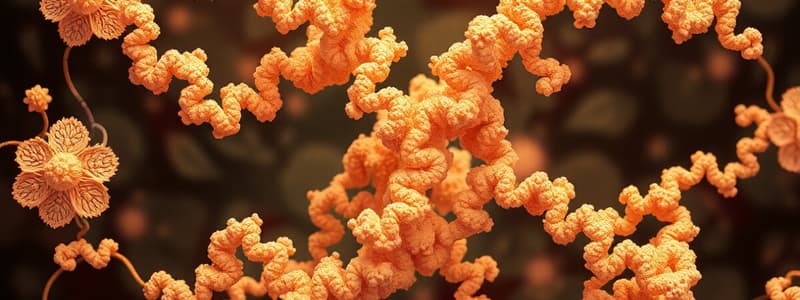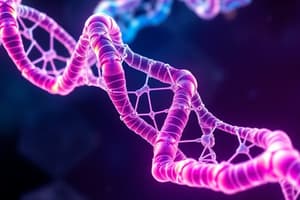Podcast
Questions and Answers
What drives the activation or inhibition of a protein?
What drives the activation or inhibition of a protein?
- Changes in conformation (correct)
- The temperature of the surroundings
- The pH level of the environment
- The concentration of substrate available
Which statement best describes the relationship between protein conformation and function?
Which statement best describes the relationship between protein conformation and function?
- Both activation and inhibition are influenced by conformational changes. (correct)
- Conformation affects function only at extreme temperatures.
- Conformation changes lead to no significant impact on function.
- Function is exclusively determined by the amino acid sequence.
What is a possible consequence of a change in protein conformation?
What is a possible consequence of a change in protein conformation?
- Increased resistance to denaturation
- Complete loss of function (correct)
- Altered substrate specificity (correct)
- Permanent structural rigidity
How can alterations in protein structure impact cellular activities?
How can alterations in protein structure impact cellular activities?
Which of the following is true regarding protein conformation changes?
Which of the following is true regarding protein conformation changes?
What distinguishes proteins from other macromolecules?
What distinguishes proteins from other macromolecules?
Which of the following statements about proteins is true?
Which of the following statements about proteins is true?
Which factor does NOT influence the shape change of proteins?
Which factor does NOT influence the shape change of proteins?
What primarily determines the final shape of a protein?
What primarily determines the final shape of a protein?
What role do environmental alterations play in proteins?
What role do environmental alterations play in proteins?
Which of the following factors does NOT affect the primary structure of a protein?
Which of the following factors does NOT affect the primary structure of a protein?
In the context of protein behavior, which statement is false?
In the context of protein behavior, which statement is false?
What is the primary structure of a protein characterized by?
What is the primary structure of a protein characterized by?
Which stage is directly involved in forming the primary structure of a protein?
Which stage is directly involved in forming the primary structure of a protein?
What role does the sequence of amino acids play in protein synthesis?
What role does the sequence of amino acids play in protein synthesis?
What is the relationship between protein structure and function?
What is the relationship between protein structure and function?
Which level of protein structure is NOT mentioned as having an impact on protein function?
Which level of protein structure is NOT mentioned as having an impact on protein function?
How does the development of protein structure influence its classification?
How does the development of protein structure influence its classification?
Which of the following statements is true about the structural levels of proteins?
Which of the following statements is true about the structural levels of proteins?
What effect do small changes in protein structure have?
What effect do small changes in protein structure have?
What is the role of nitrogen and oxygen atoms in amino acids?
What is the role of nitrogen and oxygen atoms in amino acids?
How do hydrogen bonds affect the arrangement of amino acids?
How do hydrogen bonds affect the arrangement of amino acids?
Which atoms participate in the formation of hydrogen bonds in amino acids?
Which atoms participate in the formation of hydrogen bonds in amino acids?
What is a consequence of hydrogen bonding in amino acids?
What is a consequence of hydrogen bonding in amino acids?
Which statement about amino acid structure is accurate?
Which statement about amino acid structure is accurate?
What amino acid change leads to sickle-cell anemia?
What amino acid change leads to sickle-cell anemia?
What is the charge of glutamic acid in the context of hemoglobin?
What is the charge of glutamic acid in the context of hemoglobin?
Where is glutamic acid located in the structure of hemoglobin?
Where is glutamic acid located in the structure of hemoglobin?
What effect does the substitution of glutamic acid with valine have on hemoglobin?
What effect does the substitution of glutamic acid with valine have on hemoglobin?
What type of mutation is responsible for sickle-cell anemia?
What type of mutation is responsible for sickle-cell anemia?
Flashcards
Protein Flexibility
Protein Flexibility
Proteins have a unique ability to change their shape, which is essential for their function. This shape change can be triggered by binding to other molecules, small molecules, or by changes in their environment.
Versatility of Proteins
Versatility of Proteins
Proteins are the most versatile macromolecules, playing diverse roles in biological systems.
Protein Shape Change by Binding
Protein Shape Change by Binding
Proteins can change their shape by binding to other molecules, like a key fitting into a lock.
Protein Shape Change by Environment
Protein Shape Change by Environment
Signup and view all the flashcards
Distinctive Property of Proteins
Distinctive Property of Proteins
Signup and view all the flashcards
Protein Conformation
Protein Conformation
Signup and view all the flashcards
Protein Function
Protein Function
Signup and view all the flashcards
Conformational Change
Conformational Change
Signup and view all the flashcards
Protein Activation/Inhibition
Protein Activation/Inhibition
Signup and view all the flashcards
Conformation and Function Relationship
Conformation and Function Relationship
Signup and view all the flashcards
Primary Structure
Primary Structure
Signup and view all the flashcards
Secondary Structure
Secondary Structure
Signup and view all the flashcards
Tertiary Structure
Tertiary Structure
Signup and view all the flashcards
Quaternary Structure
Quaternary Structure
Signup and view all the flashcards
Structure-Function Relationship
Structure-Function Relationship
Signup and view all the flashcards
Hydrogen Bonding in Proteins
Hydrogen Bonding in Proteins
Signup and view all the flashcards
Nitrogen and Oxygen in Protein Structure
Nitrogen and Oxygen in Protein Structure
Signup and view all the flashcards
Sickle-cell anemia cause
Sickle-cell anemia cause
Signup and view all the flashcards
Sickle-cell anemia amino acid change
Sickle-cell anemia amino acid change
Signup and view all the flashcards
Glutamic acid's role in hemoglobin
Glutamic acid's role in hemoglobin
Signup and view all the flashcards
Shape change in sickle-cell anemia
Shape change in sickle-cell anemia
Signup and view all the flashcards
Sickle-cell anemia effect on red blood cells
Sickle-cell anemia effect on red blood cells
Signup and view all the flashcards
Primary Structure of Protein
Primary Structure of Protein
Signup and view all the flashcards
How does amino acid sequence impact protein structure?
How does amino acid sequence impact protein structure?
Signup and view all the flashcards
What is the primary structure?
What is the primary structure?
Signup and view all the flashcards
What determines the primary structure?
What determines the primary structure?
Signup and view all the flashcards
What are amino acids in relation to primary structure?
What are amino acids in relation to primary structure?
Signup and view all the flashcards
Study Notes
Biochemistry Study Notes
- Proteins differ from other macromolecules because their shape changes based on their environment, achieved through binding to other molecules, or altering their surroundings.
- Each protein has many possible conformations. Even a small change in binding, environment, or factor can lead to shape changes.
- These conformational changes affect protein function, either wholly or partially.
- Protein activation or inhibition is contingent on these shape changes.
- A protein should have at least one fully active conformation (native conformation) for proper functioning, with at least one native confirmation (100% active).
- A change in protein structure can lead to changes in the protein's function, even small structural changes.
- The protein's structure (primary, secondary, tertiary, and quaternary) determines its final shape. The primary structure is the foundation and dictates the final shape.
- Protein building stages
- Determining the base (sequence) of amino acids.
- Types and sequence form the amino acid chain's linear structure (primary structure).
- Areas of the protein chain form bonds and wrap around each other, creating various protein structures, described by their bonds.
Protein Structure
-
Primary structure: determined by covalent bonds (peptide bonds) only. This is the sequence of amino acids.
-
Secondary structure: regions of the amino acid chain rotate around themselves in a specific pattern, stabilized by hydrogen bonds between the atoms of the amino acids. This creates specific local arrangements.
-
Tertiary structure: a combination of covalent bonds (disulfide bonds), hydrogen bonds, hydrophobic interactions, ionic interactions, or van der Waals forces to form the overall, 3D shape of the polypeptide chain.
-
Quaternary structure: Consists of more than one polypeptide chain. These chains are bound together by various bonds, forming multimeric proteins. Examples include hemoglobin.
-
How to determine protein chain numbers: Protein with more than one N-terminus or C-terminus means more polypeptide chains.
-
Sickle Cell Anemia: A single amino acid substitution (glutamic acid to valine) in the primary structure of protein hemoglobin causes sickle cell anemia.
-
The change affects the way hemoglobin molecules interact, leading to the aggregation of hemoglobin molecules, red blood cell deformation, and clotting issues.
-
The primary structure significantly influences the final shape and function of a protein. Similar primary structures often indicate similar functions.
Studying That Suits You
Use AI to generate personalized quizzes and flashcards to suit your learning preferences.




